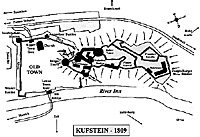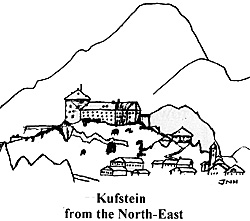The Siege Of Kufstein
1809
by John Henderson, UK
| |
Like the rest ofthe Tyrol, Kufstein came to Bavaria after the 1805 campaign, and was occupied by a small Bavarian garrison.
When the Tyroleans and Austrians threw the Bavarians out of the Tirol in 1809, the garrison consisted of
Commandant Major Maximilian Thomas von Aicher
Staff
Artillery
Fortress guns:
Mortars
Field guns: Howitzers:
Hand grenade throwers: 4
Major von Aicher had been commandant since August 1806. He was quite a veteran, having served in the Bavarian Imperial contingent from 1793 to 1796. For his bravery in the Combat of Stecken, 5th December 1805, he had been appointed a knight of the Military Max Joseph Order.
On 17th April 1809, Kufstein was invested by a battalion of Austrians, under OberstLieutenant von Reissenfels, and a large band of Tyrolean insurgents.
On the 19th, an Austrian captain presented himself before the Innsbrucker Gate, to hand Major von Aicher a summons to surrender. He was blindfolded, and led up to the fortress. He handed the following letter to Major von Aicher:
All Tirol is now under the protection of his Majesty the Emperor, my all-gracious lord. The troops ofthe VIIIth. Army Corps occupies it, under my command; General-Lieutenant von Kinkel, with all the Bavarian troops present in the Tyrol, 4600 men in number, are either dead or captured. The French General Bison with 4500 men of his troops, has likewise had to lay down his arms. His Imperial Highness the Archduke Charles, with 150,000 men, has advanced into Bavaria, and is already near its capital. All resistance in such a small fortress as Kufstein is without point. I summon you, Herr Commandant, to surrender the fortress of Kufstein to Herr Oberst-Lieutenant von Reissenfels, whom I have sent with a corps of troops, to take possession ofthis place.
The distance of the French army leaves you no hope remaining ofa relief, and an unnecessary resistance would only cause pointless shedding ofblood, which would be your responsibility alone.
Headquarters, Innsbruck, 19th April 1809
Marquis de Chasteler Major von Aicher immediately sat down and wrote the following reply:
I ask you to hold yourself convinced, that everything which you have told me of the successes of Austrian arms within and without the Tyrol, will not prevent me from defending my fortress to the last ditch. Your representations cannot be considered by a man, to whom his duty to King and fatherland is so sacred. What can perjured rebels, who everywhere surround the fortress, do against a brave garrison, which is greatly embittered by their faithlessness?
On my honour, Herr Feldmarschall-Lieutenant , nothing can be expected from these, except that the neighbouring villages and the poor little town itself will fall prey to flames.
Kufstein, 19th April 1809
von Aicher
During the night of 24th April, the Austrians emplaced three two-gun batteries on the Zellerberg, south-west of Kufstein. The middle battery consisted of 2 x 6-pdrs.; the flank batteries were of 2 howitzers each. When the day broke, the Bavarians engaged these batteries with 2 x 60-pdrs., 1 x 30 pdr., 6 x 18 pdrs., 2 x 12 pdrs., 1 x 20-pdr. mortar, 1 x 10 pdr. mortar, and 2 howitzers, firing from the Josephsburg, Pfauenschweif and Orillon. By 10 o'clock, the Austrian batteries had been silenced, and two pieces dismounted. The Bavarians had lost 1 man dead and 2 wounded. At the same time, the Austrians opened fire with 3 x 6pdrs. from the Hohe Wacht, to the south of Kufstein.
Later in the day, Oberst-Lieutenant von Reissenfels sent in a second summons to capitulate, mentioning that the Archdukes Charles and John had decisively settled the fate of the campaign. Major von Aicher again rejected the summons.
On the next day, the 26th, the opposing batteries again engaged each other for a few hours in the morning. Corpor~l Amont scored a success against the Hohe Wacht battery, with his 60-pdr. mortar on the left face ofthe Josephsburger-Bastion, when he blew up the Austrian battery's powder magazine. 3 Austrian gunners were killed, and the battery was silenced for 24 hours. On the 27th, the batteries engaged each other again during the morning.
On the 28th, the Austrians opened up at 7 o'clock in the morning, with a strong and wellaimed fire, including red-hot shot. Their targets were especially the Pfauenschweif, the Josephsburger-Bastion, the Wallachen-Bastion and the Schloss-Rondel. The bombardment lasted for 2 hours.
However, on the next day, the 29th, the Austrians began to disarm their batteries. The Bavarian General-Lieutenant von Deroy was on his way to relieve Kufstein. With their artillery away, the Austrians and Tyroleans continued to invest Kufstein, until, at 3 o'clock in the afternoon of 12th May, Deroy's advance guard appeared on the Inn Bridge and was greeted by the garrison with cheers. The fortress was reprovisioned.
The Bavarian occupation ofthe Tyrol did not last long. At the end of May, Deroy was forced to retreat back down the Inn valley. He and his division retired past Kufstein on 31st May. The Tyroleans were on their heels, and invested the fortress again.
The commander of the investing forces this time was Hauptmann Comte d'Esquille, with one infantry company, and about 1300 Tyrolean insurgents, under Speckbacher and Sieberer. They summoned the fortress; the summons was again rejected.
On the next day, 1st June, the Tyroleans managed to start a serious fire in the town. 18 houses were burnt down before this fire could be brought under control.
On 2nd June, the garrison of Kufstein made two sorties, having received news that Deroy was approaching with a relief column. The first sortie was directed against the Thierberg, west ofthe fortress. This sortie was led by Capitain von Baldinger, of 6 leichtes Infanterie-Bataillon Laroche, and consisted of 60 men and a 3-pdr. gun. The Bavarians drove the Tyroleans from their positions on the Thierberg: the latter commanded by Hauptmann Rainer, of the Kufsteiner Schützen-Compagnie. The second sortie, against the Sparchen Mill, to the north, was carried out by Ober-Lieutenant Walther, with 69 men and a 3-pdr. Both parties retreated back into the fortress in the evening: Deroy had not appeared.
On 5th July, Deroy succeeded in relieving Kufstein, with 10 Linien Infanterie-Regiment Junker, Reserve-Bataillon of 5 Linien-Infanterie-Regiment Preysing, 2 squadrons and a battery. The fortress was reprovisioned. The light infantry of the garrison were relieved by the reserve battalion. Deroy retired north again the same day.
By the second half of July, the Bavarians were ready for another attack on the Tyrol. Comte d'Esquille's besieging force retired from Kufstein on the 26th and 27th of that month.
Once again, King Max Joseph's forces were worsted, and withdrew fiom the Tyrol. Kufstein was invested again. On 24th. September, Major von Aicher received an unchivalrous letter from Andreas Hofer, which included the following lines:
On the night of 10th December, the Tyroleans made an unsuccessful attempt to storm the bridgehead.
But now the Bavarians, with French and Italian help, came back in force. Deroy relieved Kufstein again on 18th October, and marched on up the Inn valley to ultimate victory.
The King acknowledged his garrison's fine conduct, in an Army Order of 10th May 1810:
Kufstein's Kriegsjahre, by Major Maximilian Schlagentweit, in 'Darstellungen aus der Bayerischen Kriegs- und Heeresgeschichte', Volume 12, (J. Lindau, Munich, 1903)

Large Map of Kufstein 1809 (slow: 70K)
Back to Table of Contents -- First Empire #42 Back to First Empire List of Issues Back to MagWeb Master Magazine List © Copyright 1998 by First Empire. This article appears in MagWeb (Magazine Web) on the Internet World Wide Web. Other military history articles and gaming articles are available at http://www.magweb.com |
 Kufstein is a small Tyrolean fortress, built on a hill beside the River Inn, where that river crosses the Bavarian border. As can be seen from the plan, the main works are on the northern part of the hill, with outworks to the south. Abutting against the fortress on its north face is a small fortified town, with unfortified suburbs to its north and east.
Kufstein is a small Tyrolean fortress, built on a hill beside the River Inn, where that river crosses the Bavarian border. As can be seen from the plan, the main works are on the northern part of the hill, with outworks to the south. Abutting against the fortress on its north face is a small fortified town, with unfortified suburbs to its north and east.